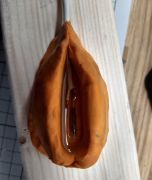|
Maybe Ram board (no water). Does your MIG really spatter that much on 80/20 gas?
|
|
|
|

|
| # ? Apr 19, 2024 19:38 |
|
Not more spatter than MIG in general I guess, but way more than TIG does at any event. I could probably get away with building a box-like spatter catching structure and keep it just under the welding area and it would probably catch almost everything. It turns out I can get Ram-board (which I've never heard of) where I live (not the US). I'll look into it. It's pretty pricy at Ä180 for a roll but that's 30 square meters which is plenty and if it indeed works for spatter it would be a good solution. Part of me is too lazy to use the MIG - it's big and heavy, nearly 100 kg so I need help to move it from the shop (it has wheels though) unlike the TIG which is a fairly portable inverter machine that runs on a standard 230v outlet. The MIG uses 3-phase from an outlet type I don't have at home. I do have residential 3-phase though, I could just make an adapter from the stove outlet or better yet wire a socket into an unused triple group of breakers I have just sitting there in the box being no good to me right now, so neither of these things are actually real obstacles, just more work. I'm way more experienced and confident with the MIG than the TIG, especially when overhead or vertical and not sitting comfortably on a stool at the welding table with everything including my hands propped up.
|
|
|
|
If you're just tacking things before.mocimg to weld em up elsewhere seems like tig would be perfect? Also this sounds like exactly what welding blankets are for, protecting things from sparks and spatter. Are you going to be coping and fitting the pieces in the house, or will that all be done outside or something? I usually find that's usually a big mess and the most important thing to get right for clean joins and accurate dimensions.
|
|
|
|
I've had pretty good luck covering stuff with cardboard boxes and/or cheap padded moving blankets (that our mover left behind) I weld within a couple feet of a nice leather couch I have in storage and haven't had any issues welding near it, and I'm using flux core which spatters a good amount I wouldn't use like, newspaper, but moving-box cardboard is generally ok if you are just tacking things, and you keep a close eye on it. I've done welding around bearings and stuff and caught the cardboard on fire then, but that's because I was laying down a reasonably thick bead on 1/4" plate half an inch away Hadlock fucked around with this message at 20:33 on Apr 18, 2024 |
|
|
|
meowmeowmeowmeow posted:If you're just tacking things before.mocimg to weld em up elsewhere seems like tig would be perfect? Yeah I'm looking at additional welding blankets. There are silicone coated fiberglass ones that are well reviewed, seems like a couple of those in addition to what I already have and what leather I can scrounge up should probably see me through. I plan on doing as much prep work as possible in the shop (like if the mandrel bends I end up ordering aren't already beveled at the edges I'll do that on the belt sander), and use the chop saw and do the vast majority if not all of angle grinding outside when fitting everything up. Some assemblies can probably be completely shop fabricated just from measurements, it's mainly the handrails that I know for sure I absolutely want to tack on site. The handrails are really what will make or break this project aesthetically so I want to get those right, and they'll be the trickiest part. There's some other bits too, but they seem pretty straightforward. Like some kind of toddler blocking fence, for example. I don't have toddlers anymore but I'd hate for someone else's to fall to death in my home. I'll experiment with turning up some kind of internal sleeves for helping with handrail parts alignment. You probably can't insert one very far into a bend (which is the only place I'll make joints) but I don't need much and it's worth a shot. Buying a tube clamp or two is probably a good idea. Some good and sharp quality hammer drill bits that can cut through rebar easily if I find those where I absolutely need a hole. I'm also buying a pipe sander for this project. I might never use one again but it seems like I'll absolutely need one, and there's none for rental locally that I can find, at least not for amateurs. Hadlock posted:I've had pretty good luck covering stuff with cardboard boxes and/or cheap padded moving blankets (that our mover left behind) I weld within a couple feet of a nice leather couch I have in storage and haven't had any issues welding near it, and I'm using flux core which spatters a good amount Invalido fucked around with this message at 21:00 on Apr 18, 2024 |
|
|
|
Ram board is heavy duty cardboard. Similar in thickness to corrugated cardboard, but without the corrugation. It's dead tree the whole way through. It's for protecting floors during a remodel, meant for workers to walk on. It's probably way overkill for spatter. Definitely check it out in person before buying 30 sq meters of it.
|
|
|
|
Also think about what you're welding and how much heat is actually going into it. I've done some "farm grade" welding in sandals and while I don't like how it feels when I get spatters on my skin it's not burning holes in me. I'm mostly only welding 16 gauge steel and I have to be really careful to not put too much heat into it or risk burning through it I would imagine if you're welding together 1/4 or 1/2 plate together, you are throwing off much hotter, larger globules of spatter Last time I checked metal residential railing supplies they were mostly 16ga and the guy warned me off it because it's such delicate stuff to weld without TIG I'm a welding hobbyist though so I'm mostly just guessing Hadlock fucked around with this message at 22:16 on Apr 18, 2024 |
|
|
Iím going to try making a couple rings for funsies, like with a metal core and some wood features on the outside. Iíll be doing it in my wood lathe, and for ease of just trying it out, ordered a couple blanks, like these: But if I find I enjoy this, I might be happier making my own cores from scratch on my little metal lathe, not the fancy materials, but Iím sure I could do stainless at this scale. Interested in thoughts on what that process would look like, though. I can turn down the outer diameter just fine, and bore the center out no problem, but thatís just a straight profile through, ideally the inner face would be a nice curve at each end. I figure I could get the tail end curved one way or another, probably a bunch of approximate steps of angled passes and maybe some file work, but then what, just part it off and flip it over and grab it in the 4-jaw chuck while itís still got plenty of meat for strength? And then Iíd need to bring down the outside, but they have ring mandrels for that, so that part seems easy enough. I guess the process as I can see it now just seems a little shakey, wondering if anyone sees a better series of steps. Currently something like: 1: facing 2: turning (at much larger than target diameter, for re-chucking later) 3: bore center 4: radius tail end of bore 5: part off 6: flip, re-chuck 7: radius tail end of bore (was head end) 8: mount on ring mandrel 9: turn to final outer diameter Although 4-7 could also come after 9, but you have a much weaker piece of metal to grip in the chuck at that point.
|
|
|
|
|
Form tool on the inside to do the internal profile before parting? Seems like if you started with tube you could form the inside, cut the OD, part off, then clean up the burr as a final hand step or something.
|
|
|
|
Oh, custom tooling, hadnít thought of that. Something like this? https://youtu.be/cNeV_SsKodA?si=VMmbFTg1RRL7MZBb From absolute scratch like that, it involves some capabilities I currently lack, but I like the idea, certainly a much better way to get consistent results.
|
|
|
|
|
Collets for sure over a chuck, so deformation won't be a problem with thin tube walls. Form tools in stainless will want all the support you can get, 304 tubing tends to be nasty. Got a 5C?
|
|
|
|

|
| # ? Apr 19, 2024 19:38 |
|
Bad Munki posted:Oh, custom tooling, hadnít thought of that. Something like this? Depending on how wide the ring ends up you might be able to get away with a regular radius cutter on each side. https://www.mcmaster.com/products/radius-cutters/curve-cutting-lathe-tools/
|
|
|












